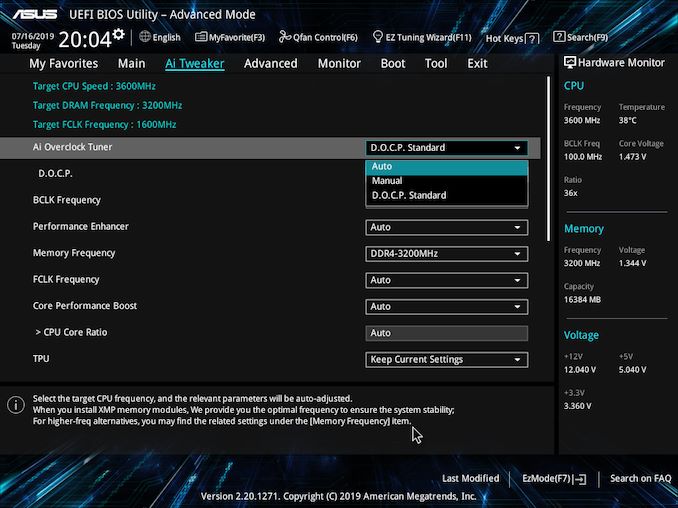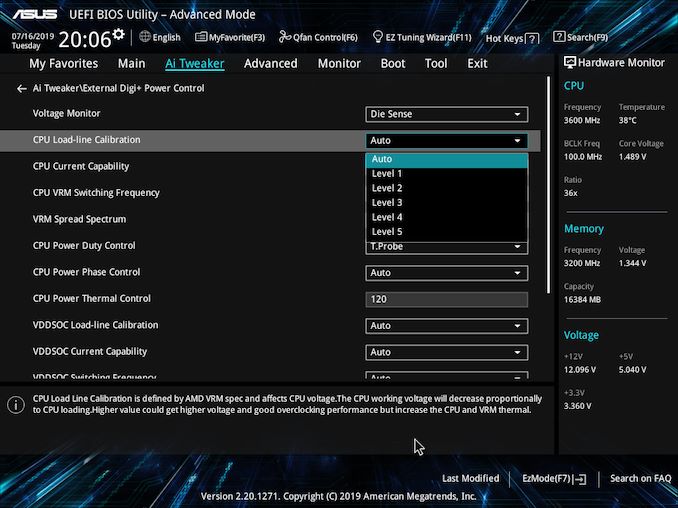The ASUS Pro WS X570-Ace Review: x8x8x8 with No RGB
by Gavin Bonshor on August 12, 2019 9:00 AM ESTOverclocking Ryzen 3000
Experience with the ASUS Pro X570-Ace
The expected overclocking potential prior to the launch of the Ryzen 3000 series hasn't lived up to all the hype that was surrounding it. Regardless of this, the limitations could be in the new 7 nm manufacturing process, the use of the chiplet design, or the very high temperature that these processors run at when overclocked. It remains to be seen in the next revision whether or not the clock speeds will be more fruitful for what enthusiasts expect, but when overclocking the Ryzen 3000 processors, premium cooling methods such as high-end AIOs and custom water cooling is needed.
Overclocking our Ryzen 7 3700X using the ASUS Pro WS X570-Ace via the firmware was easy without much pomp and show. All of the overclocking options including both the CPU, memory, voltage and power settings can be found within the Ai Tweaker section. Users can either opt to use the basic overclocking functions within the AI Suite 3 software or use the acclaimed Ryzen Master overclocking software which as far as AMD overclocking goes, works very well. When overclocking the memory on ASUS branded AMD motherboards, what is more commonly known as X.M.P is called D.O.C.P; this is the exact same thing, no difference, just a different naming structure.
The power-related settings can be found under the External Digi+ Power Control menu, with options for variables such as Load-Line Calibration which is useful for eliminating VDroop on the CPU VCore, VDDSoC settings, and enabling or disabling spread spectrum. There are no real overclocking presets to select from and that's okay given that this model is more for professional users, but there are three performance enhancer settings to select from.
Overclocking Methodology
Our standard overclocking methodology is as follows. We select the automatic overclock options and test for stability with POV-Ray and OCCT to simulate high-end workloads. These stability tests aim to catch any immediate causes for memory or CPU errors.
For manual overclocks, based on the information gathered from the previous testing, starts off at a nominal voltage and CPU multiplier, and the multiplier is increased until the stability tests are failed. The CPU voltage is increased gradually until the stability tests are passed, and the process repeated until the motherboard reduces the multiplier automatically (due to safety protocol) or the CPU temperature reaches a stupidly high level (105ºC+). Our testbed is not in a case, which should push overclocks higher with fresher (cooler) air.
Overclocking Results
The ASUS Pro WS X570-Ace has a capable 12+2 phase power delivery running in 6+1 configuration with an ASP1405I which operates at 6+1. While running the manual overclock testing, we noticed very little VDroop once we ran 3.7 GHz at 1.250 V and above, all the way to 4.3 GHz at 1.375V. This shows that the automatic LLC setting runs pretty much spot on in our testing which means that what voltage is set in the firmware, is the voltage that our Ryzen 7 3700X ran at when under full load.
Performance in our POV-Ray testing from 3.6 GHz to 4.3 GHz showed a consistent increase in performance, and the ASUS Pro WS X570-Ace managed to push our Ryzen 7 3700X to its limitations of 4.3 GHz at 1.375 V. We did go for 4.4 GHz, but even with 1.550 V on the CPU VCore which for the record is way too much, it still wasn't any more stable.
When using the three levels of performance enhancement profiles, we found that they pumped a similar amount of CPU VCore voltage (around 1.375-1.384 V), but it didn't quite match up to the performance in POV-Ray than our manually overclocked 4.3 GHz with 1.375 V. All three profiles we're actually similar to just enabling Precision Boost Overdrive in terms of temperatures, POV-Ray performance and power draw; these are more PBO focused enhancements as opposed to overclocking profiles.













110 Comments
View All Comments
umano - Wednesday, August 14, 2019 - link
It seems a great mb and it has a wonderful look. It is not the board for me, I'd go HEDT with an Atx board, but I like the approach based on quality, caring about details that do not shine on paper or on images but they shine on performance, reliability and why not pleasure to use. The shield and separation for the audio it is a needed touch of design elegance.I really hope this is not the last we heard from x570 boards, to me the x570 offer lacks an outstanding pro oriented Itx board.
FredeBR - Wednesday, August 14, 2019 - link
I saw comments that 3900x works very hot (high temperature). On this asus board is it possible to configure processor downclock, like lowering the cpu voltage? I will use for full load processing for more than 24 hours in a row.TheinsanegamerN - Thursday, August 22, 2019 - link
The 3900x is a 12 core CPU. It's goona need some big boy cooling. If you dont want to deal with the heat you should probably stick with an 8 core ryzen. You could turn off turbo boost, but then why bother shelling out more for the big chips if youre just gonna kneecap it?abufrejoval - Thursday, August 15, 2019 - link
As much as I like the 3x8 general option, it pains me that the first logical addition to a GPU and perhaps a RAID controller, 10GBase-T Ethernet is going to swallow 8 lanes of PCIe 4, while a single lane would be quite sufficient and actually the Ethernet IP block for that is already supposed to be inside the 'chipset'! And that price, whatever licence cost required to make use of it, should be included.Otherwise it looks like one of the sanest mainboard designs I have seen so far.
alpha754293 - Thursday, August 15, 2019 - link
"One of the key elements to this board design is the x8/x8/x8 PCIe 4.0 slot layout. This motherboard is the only one on the market that uses a full PCIe 4.0 x8 lane available from the AMD X570 chipset, enabling an array of different use cases that ASUS believes this market needs. Technically the upstream link to the CPU is still limited to PCIe 4.0 x4, however this does enable PCIe 3.0 x8 cards to have full bandwidth, which accounts for a lot of add in cards (RAID, high-end networking)."This is quite possibly one of the worst boards on the market then.
They have three PCIe 4.0 x16 physical slots, but either only run at its native x16 speeds if you only have one card installed, x8 if you have two, and really x8/x8/**x4** if you have three cards installed since the chipset to CPU interface is a PCIe 4.0 **x4** link.
That is so dumb.
Why would they bother putting in a x16 physical slot, and then because of the chipset link, only run it at x4 electrically?
Quite possibly one of the worst product development/engineering decisions ever.
A single NVMe PCIe 4.0 x4 SSD would be able to consume all of that bandwidth.
moriz - Friday, August 16, 2019 - link
i think the key here is that the third slot can *supposedly run at PCIe **3.0** x8, which allows it to give full bandwidth to any PCIe 3.0 x8 add-in card.*supposedly, because i've yet to see any confirmation that it is capable of doing the PCIe version switch.
YaroslavZ - Sunday, August 18, 2019 - link
hey! , I bought this mobo a couple of days ago, I bought it because I wanted to upgrade my old cpu to R9 3900X, I also happened to have 4 R9 390 gpus (2 390s 2 390x) , sadly I don't have the cpu yet, I do have the r5 1400 lying around but I don't feel like taking it out from completely different cpu and adding it into that costly mobo just to test things out,I bought that mobo exactly to run 4way CFX with these gpus, 8x 8x 4+4x* & 4x from m.2 to pcie adapter,
based on your words, in theory the 3rd slot should be able to use more bandwidth than a simple 4x 3.0 , is that correct? if so then that will pretty good upgrade over a simple 4x.
anyways just to give you some info, a simple 4x 3.0 uses around 70~75% power of R9 390, while 8x around 99% ,
I do know that because atm i'm sitting through 8x 8x 4x in asus z170-a , which also have m.2 at x4 so 4way is possible as well but I bought the adapter just recently and I don't really want to sit through sata ssd, as well as this mobo currently have problems with 2 ram slots because of which I can't use dual channel atm, which obviously makes 3gpus to barely outperform a single gpu so adding 4th on top of that is pointless, wish the prices on r9 3900x will fall soon.
here is stock 3way (8x 8x 4x) 3dmark (firestrike ultra) score in dual channel when I still had it, also, R9 390X performing with stream processors of R9 390's if I got it right(aka it's like 3x of R9 390 even when some of them have X's), because I was forced to use R9 390 as gpu1 to enable CFX,, https://www.3dmark.com/fs/18192586
tristank - Tuesday, August 20, 2019 - link
How does this even works? Is there some kind of translation between PCIe 4.0 x4 to PCIe 3.0 x8. I dont get it. I thought this was not possible.JKJK - Friday, August 16, 2019 - link
A card like this without 10GbE is completely idiotic.You shouldn't have to waste a pci-e port on it. And it should be intel. Let the gamers use the unstable Aquantica shit chips and drivers (been there, done that).
Tomyknee - Sunday, September 1, 2019 - link
All I hear about is the chipset fan. I have read (Buildazoid in May 2019 Gig Master review) that it is the RAID setups going through the Chipset that sets the fan off. Unfortunately the second M.2 is only PCIe x2. Other than SATA drives maxed at 6gbs, it does not make sense to run RAIDO for speed. Samsung will have PCIe 4.0 NVMe M.2 that surpase 7gbs R/W within a year and the 2x will not take advantage of that.A deal breaker for me, (I really like this board, really want to order it - looks great and no RGB!)